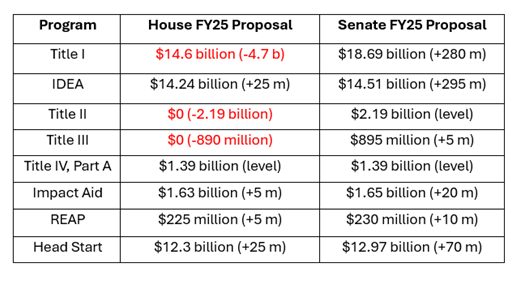On August 1, 2024, the Senate Appropriations Committee passed its FY25 Labor, Health and Human Services, and Education (LHHS) proposal. The bill increased funding for the Department of Education (ED) by $1 billion, including increases for Title I (+280 million) and IDEA (+295 million). This proposal is in stark contrast to the House proposal which cut funding for ED by $11 billion, reducing Title I by 25% (-4.7 billion) and eliminating several programs, including Titles II and III. Congress is now home for August recess and will not return until September. Upon their return, the overall assumption is that both chambers will focus on passing a continuing resolution to fund the government past the September 30 deadline.
Although it is unlikely this Congress will pass a full FY25 spending bill soon, it is important to take the proposals from each chamber as a representation of their priorities. Here’s a snapshot of the proposals:

In addition to the increases mentioned above, the Senate FY25 LHHS proposal included $160 million for two critical school mental health programs: Mental Health Service Professional Development Grant Program and School-Based Mental Health Services Grant Program - which provide funding to school districts, state agencies and institutions of higher education to build the pipeline of school mental health professionals. The bill report also included directives to the Department of Education on how to increase access to these grant programs, including a requirement of at least 90 days to submit an application, notifying potential applicants of the grant opportunities, and providing robust technical assistance like webinars and direct communication with interested entities.
AESA has long been advocating for these common-sense changes to ensure more districts have access to federal grants – and we are excited to see the Senate’s attention to this important issue.
When Congress returns in September, we will be watching for how long the continuing resolution will be for – precedent shows that Congress usually funds the government until after the election. The lame duck Congress will then decide whether or not to fully fund the government – or pass another CR and kick FY25 appropriations to the 119th Congress. Stay tuned!
